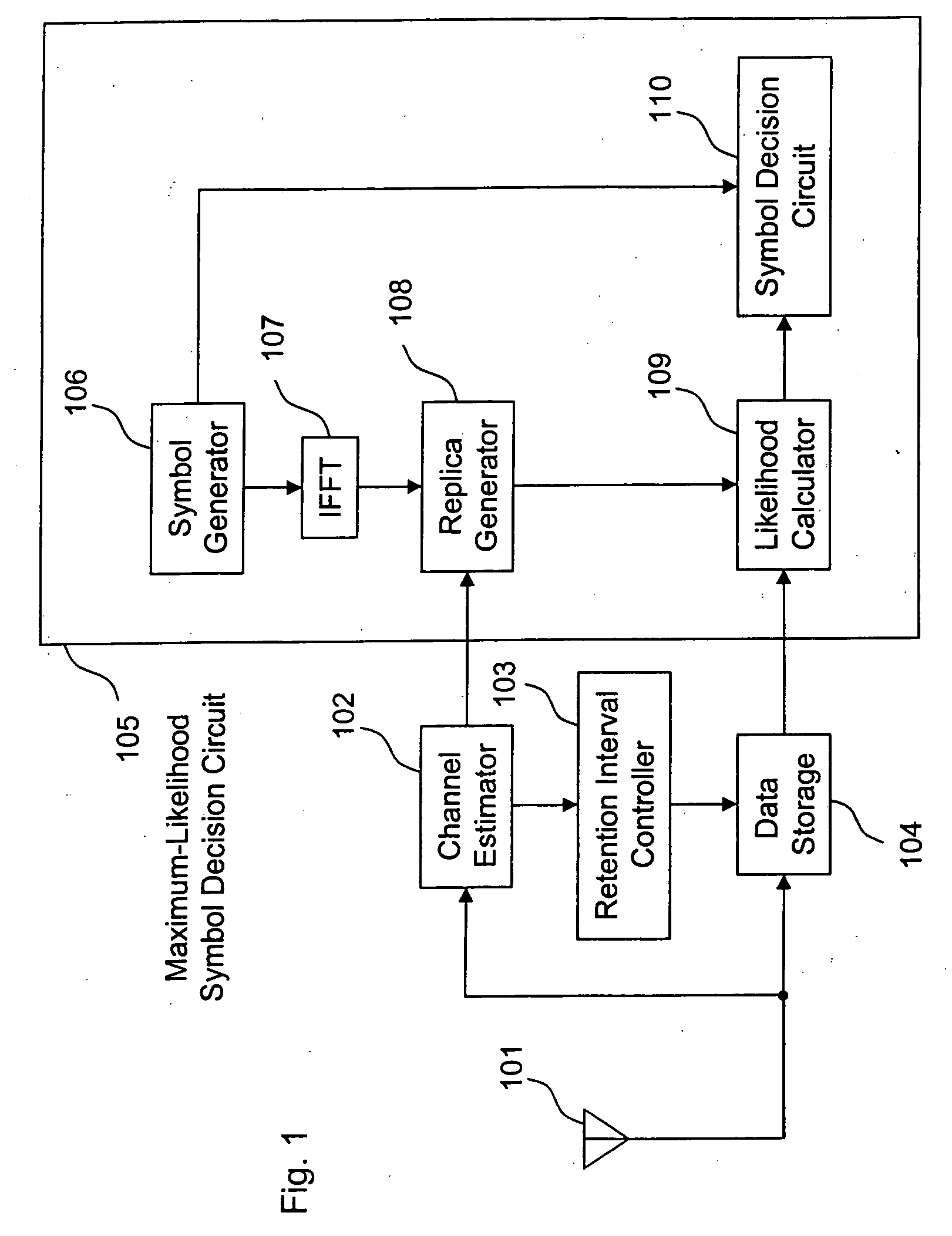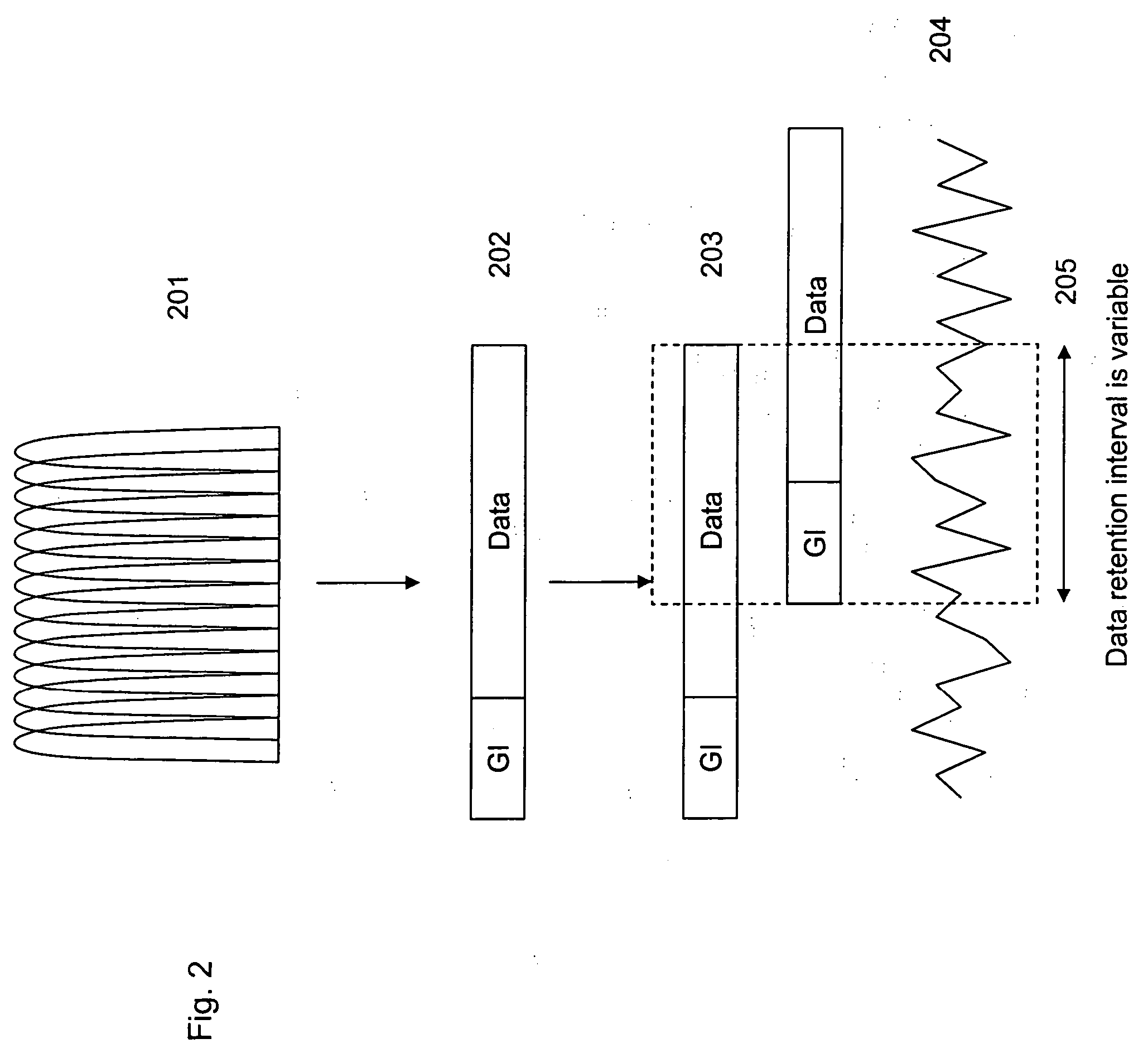Orthogonal frequency division demodulator, method and computer program product
a demodulator and orthogonal frequency technology, applied in the field of orthogonal frequency division multiplexing demodulators, can solve problems such as deterioration of reception characteristics
- Summary
- Abstract
- Description
- Claims
- Application Information
AI Technical Summary
Benefits of technology
Problems solved by technology
Method used
Image
Examples
first embodiment
[0047]FIG. 1 is a block diagram of an OFDM demodulator according to a first embodiment that includes an antenna 101, a channel estimator 102, a retention interval controller 103, a data storage 104 and a maximum-likelihood symbol decision circuit 105. The maximum-likelihood symbol decision circuit 105 includes a symbol generator 106, an IFFT (inverse fast Fourier transformer) 107, a replica generator 108, a likelihood calculator 109 and a symbol decision circuit 110.
[0048] The antenna 101 receives an OFDM signal and delivers the received signal to an LNA (low noise amplifier). The LNA amplifies the OFDM signal to a desired amplitude. A frequency converter converts the OFDM signal amplified by the LNA, into an IF (intermediate frequency) band. A variable-gain amplifier adjusts the frequency-converted OFDM signal to an appropriate signal level. An orthogonal demodulator subjects the level-adjusted OFDM signal to an orthogonal demodulation into a baseband signal. An A / D converter conv...
second embodiment
[0065]FIG. 4 is a block diagram of a second embodiment that corresponds to a case of performing error correction decoding. An OFDM demodulator according to the second embodiment extinguishes the data of subcarriers in accordance with the correctability of the error correction decoding to decrease the number of symbol candidates. Identical reference numerals are assigned to the same apparatus parts as in the OFDM demodulator of the first embodiment and these parts are omitted from following description.
[0066] As shown in FIG. 4, the OFDM demodulator of the second embodiment includes a deinterleaver 401 and a convolutional decoder 402 in addition to the parts of the OFDM demodulator of the first embodiment.
[0067] The deinterleaver 401 deinterleaves a symbol selected by a maximum-likelihood symbol decision circuit 105. The convolutional decoder 402 subjects the deinterleaved signal to convolutional decoding. The convolutional decoding is one of the error correction decoding technique...
third embodiment
[0070]FIG. 6 is a block diagram of a third embodiment that extinguishes data of subcarriers in accordance with a modulation scheme and error correction coding rate of a carrier to decrease a number of symbol candidates. Identical reference numerals are assigned to the same apparatus parts as in the OFDM demodulators of the first and second embodiments and these parts are omitted from the following description.
[0071] As shown in FIG. 6, the OFDM demodulator of this embodiment includes a transmission information detector 603.
[0072] A maximum-likelihood symbol decision circuit 601 sets some of the subcarriers to zero based on the modulation scheme and error correction coding rate (convolutional coding rate in this embodiment) of a carrier, generates a replica signal based on a channel response value from a channel estimator 102, and selects a symbol that maximizes the likelihood of the replica signal being equivalent to a digital signal stored in a data storage 104.
[0073] A symbol g...
PUM
 Login to View More
Login to View More Abstract
Description
Claims
Application Information
 Login to View More
Login to View More - R&D
- Intellectual Property
- Life Sciences
- Materials
- Tech Scout
- Unparalleled Data Quality
- Higher Quality Content
- 60% Fewer Hallucinations
Browse by: Latest US Patents, China's latest patents, Technical Efficacy Thesaurus, Application Domain, Technology Topic, Popular Technical Reports.
© 2025 PatSnap. All rights reserved.Legal|Privacy policy|Modern Slavery Act Transparency Statement|Sitemap|About US| Contact US: help@patsnap.com



